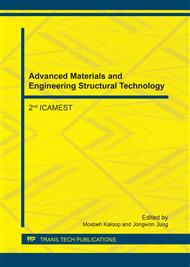[1]
A. K. Nasution, H. Hermawan, Degradable Biomaterials for Temporary Medical Implants, Springer International Publishing, Berlin, Germany, (2016).
Google Scholar
[2]
H. S. Brar, M. O. Platt, M. Sarntinoranont, P. I. Martin, M. V. Manuel, Magnesium as a biodegradable and bioabsorbable material for medical implants, Jom-J Min. Met. Mat. S. 61(9) (2009) 31-34.
DOI: 10.1007/s11837-009-0129-0
Google Scholar
[3]
F. Witte, The history of biodegradable magnesium implants: A review, Acta Biomater. 6(5) (2010) 1680-1692.
Google Scholar
[4]
B. L. Mordike, T. Ebert, Magnesium : Properties — applications — potential, Mater. Sci. Eng. A 302(1) (2001) 37-45.
Google Scholar
[5]
A. Purnama, H. Hermawan, J. Couet, D. Mantovani, Assessing the biocompatibility of degradable metallic materials: State-of-the-art and focus on the potential of genetic regulation, Acta Biomater. 6(5) (2010) 1800-1807.
DOI: 10.1016/j.actbio.2010.02.027
Google Scholar
[6]
S. Farè, Q. Ge, M. Vedani, G. Vimercati, D. Gastaldi, F. Migliavacca, L. Petrini, S. Trasatti, Evaluation of material properties and design requirements for biodegradable magnesium stents, Matéria 15(2) (2010) 96-103.
DOI: 10.1590/s1517-70762010000200002
Google Scholar
[7]
N. T. Kirkland, J. Lespagnol, N. Birbilis, M. P. Staiger, A survey of bio-corrosion rates of magnesium alloys, Corros. Sci. 52(2) (2009) 287-291.
DOI: 10.1016/j.corsci.2009.09.033
Google Scholar
[8]
Y. Chen, Z. Xu, C. Smith, J. Sankar, Recent advances on the development of magnesium alloys for biodegradable implants, Acta Biomater. 10(11) (2014) 4561-4573.
DOI: 10.1016/j.actbio.2014.07.005
Google Scholar
[9]
Y. F. Zheng, X. N. Gu, F. Witte, Biodegradable metals, Mater. Sci. Eng., R 77 (2014) 1-34.
Google Scholar
[10]
D. Hong, P. Saha, D. T. Chou, B. Lee, B. E. Collins, Z. Tan, Z. Dong, P. N. Kumta, In vitro degradation and cytotoxicity response of Mg–4% Zn–0. 5% Zr (ZK40) alloy as a potential biodegradable material, Acta Biomater. 9(10) (2013) 8534-8547.
DOI: 10.1016/j.actbio.2013.07.001
Google Scholar
[11]
W. Zhang, Y. Shen, H. Pan, K. Lin, X. Liu, B. W. Darvell, W. W. Lu, C. Jiang, L. Deng, D. Wang, Effects of strontium in modified biomaterials, Acta Biomater. 7(2) (2011) 800-808.
DOI: 10.1016/j.actbio.2010.08.031
Google Scholar
[12]
P. J. Marie, Strontium ranelate: a physiological approach for optimizing bone formation and resorption, Bone 38 (2 Suppl 1) (2006) 10-14.
DOI: 10.1016/j.bone.2005.07.029
Google Scholar
[13]
A. Oyane, K. Onuma, A. Ito, H. M. Kim, T. Kokubo, T. Nakamura, Formation and growth of clusters in conventional and new kinds of simulated body fluids, J Biomed. Mater. Res. A 64(2) (2003) 339-348.
DOI: 10.1002/jbm.a.10426
Google Scholar
[14]
N. N. Aung, W. Zhou, Effect of grain size and twins on corrosion behaviour of AZ31B magnesium alloy, Corros. Sci. 52(2) (2010) 589-594.
DOI: 10.1016/j.corsci.2009.10.018
Google Scholar
[15]
Z. Shi, J. Hofstetter, F. Cao, P. J. Uggowitzer, M. S. Dargusch, A. Atrens, Corrosion and stress corrosion cracking of ultra-high-purity Mg5Zn, Corros. Sci. 93 (2015) 330-335.
DOI: 10.1016/j.corsci.2015.01.032
Google Scholar
[16]
ASTM International, Standard test methods for determining average grain size E110-96e3, West Conshohocken, USA, (2004).
Google Scholar
[17]
E. F. Emley, Principles of Magnesium technology, Pergamon Press, Oxford, UK, (1966).
Google Scholar
[18]
M. Qian, D. H. Stjohn, M. T. Frost, Effect of Soluble and Insoluble Zirconium on the Grain Refinement of Magnesium Alloys, Mater. Sci. Forum 419-422 (2003) 593-598.
DOI: 10.4028/www.scientific.net/msf.419-422.593
Google Scholar
[19]
H. Li, Q. Peng, X. Li, K. Li, Z. Han, D. Fang, Microstructures, mechanical and cytocompatibility of degradable Mg–Zn based orthopedic biomaterials, Mater. Des. 58 (2014) 43-51.
DOI: 10.1016/j.matdes.2014.01.031
Google Scholar
[20]
M. Masoumi, M. Pekguleryuz, The influence of Sr on the microstructure and texture evolution of rolled Mg–1%Zn alloy, Mater. Sci. Eng. A 529 (2011) 207-214.
DOI: 10.1016/j.msea.2011.09.019
Google Scholar
[21]
Y. C. Lee, A. K. Dahle, D. H. Stjohn, The role of solute in grain refinement of magnesium, Metall. Mater. Trans. A 31(11) (2000) 2895-2906.
DOI: 10.1007/bf02830349
Google Scholar
[22]
X. N. Gu, X. H. Xie, N. Li, Y. F. Zheng, L. Qin, In vitro and in vivo studies on a Mg–Sr binary alloy system developed as a new kind of biodegradable metal, Acta Biomater. 8(6) (2012) 2360-2374.
DOI: 10.1016/j.actbio.2012.02.018
Google Scholar
[23]
Y. Ding, Y. Li, C. Wen, Effects of Mg17Sr2 Phase on the Bio-Corrosion Behavior of Mg–Zr–Sr Alloys, Adv. Eng. Mater. 18(2) (2016) 259-268.
DOI: 10.1002/adem.201500222
Google Scholar
[24]
R. G. Guan, A. F. Cipriano, Z. Y. Zhao, J. Lock, T. Di, T. Zhao, T. Cui, H. Liu, Development and evaluation of a magnesium-zinc-strontium alloy for biomedical applications - Alloy processing, microstructure, mechanical properties, and biodegradation, Mater. Sci. Eng. C 33 (2013).
DOI: 10.1016/j.msec.2013.04.054
Google Scholar
[25]
M. Bornapour, N. Muja, D. Shum-tim, M. Cerruti, M. Pekguleryuz, Biocompatibility and biodegradability of Mg-Sr alloys: The formation of Sr-substituted hydroxyapatite, Acta Biomater. 9(2) (2013) 5319-5330.
DOI: 10.1016/j.actbio.2012.07.045
Google Scholar
[26]
H. S. Brar, J. Wong, M. V. Manuel, Investigation of the mechanical and degradation properties of Mg–Sr and Mg–Zn–Sr alloys for use as potential biodegradable implant materials, Mol. Cancer. Ther. 7 (2012) 87-95.
DOI: 10.1016/j.jmbbm.2011.07.018
Google Scholar
[27]
W. U. Lu, F. S. Pan, M. B. Yang, W. U. Ju-ying, T. T. Liu, As-cast microstructure and Sr-containing phases of AZ31 magnesium alloys with high Sr contents, Trans. Nonferrous Met. Soc. China 21(4) (2011) 784-789.
DOI: 10.1016/s1003-6326(11)60781-4
Google Scholar
[28]
K. D. Ralston, N. Birbilis, Effect of Grain Size on Corrosion: A Review, Corro. 66(7) (2010) 319-324.
Google Scholar
[29]
G. B. Hamu, D. Eliezer, L. Wagner, The relation between severe plastic deformation microstructure and corrosion behavior of AZ31 magnesium alloy, J. Alloys Compd. 468(1-2) (2009) 222-229.
DOI: 10.1016/j.jallcom.2008.01.084
Google Scholar



